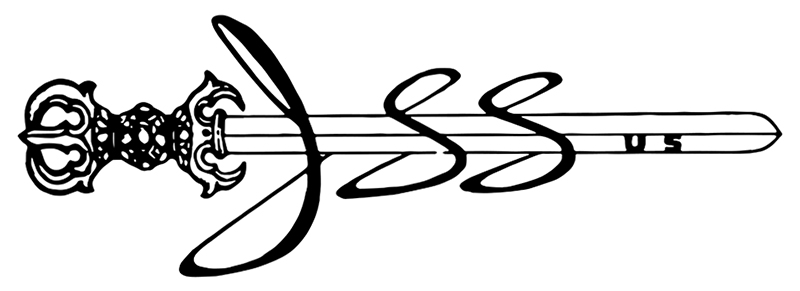
Real-Life Kantei of swords #18: An intellectual escapade
By F.A. B. Coutinho (coutinho@dim.fm.usp.br)
Real-Life
Kantei of swords #18: An intellectual
escapade
F.A. B. Coutinho
(coutinho@dim.fm.usp.br)
In previous articles, swords of well- known swordsmiths were described. This
article discusses a katana signed 加州住包永作 a wakizashi signed 加州包永作 .and a yari signed 加州住包永. by what
appears to be an obscure smith called Kashu Kanenaga. Both swords have NBTHK certificates and the wakizashi is well-described by known
experts. The aim is to show the readers how difficult it was some time ago to identify
less well-known smiths and more importantly to understand the certificates. There
is information in the certificates that the curious owner should want to
understand. There are other reasons given below.
Although, this wakizashi’s smith is not well-known, this sword is
interesting for three reasons.
First, the
time of its production appears to be from the 安土桃山時代(
Azuchi–Momoyama period (1573- 1615 )) that is from Eiroku (1558–1570) to the beginning
of Keicho (1596–1615). This
period corresponds to the end of the Sengoku
Jidai when tremendous infantry battles took place. In Japan, as in Europe (DeVries (1966)), battles using only Calvary became very inefficient.
Instead, battles became more strategic, like a game in which three kinds of weaponry
were the primary playing pieces. These were calvary, artillery (with cannons)
and infantry. These types of weaponry were used very strategically, like in a
game of scissors, stone, and paper, but with fewer elements of luck. During this
time many great generals, such as Uesugi Kenshin, Takeda Shingen, Oda
Nobunaga, distinguished themselves and some died in battle. However, infantry
battles were fought by common soldiers, not nobles, who must be properly armed
to be victorious. The sword we will discuss might have been made for these
warriors.
Second, the wakizashi is unusual. It is reminiscent of the Roman Gladius
infantry sword, which was used for close combat or for hacking away at things much
like you would use a machete. It is an atypical blade; very thick, heavy, short
for the era and specially quenched. It looks like a true battle sword.
Third, the wakizashi has NBTHK
Hozon certificates attributing it to the
Shinto period. See figure 2 below. Since the blade is signed and certified, as
mentioned before, one would think that nothing more could be added. The
certificate does not say how its conclusion was reached. Perhaps, since the
NBTHK has a huge data bank with oshigata of swords they checked the signatures and identified
the smith.
The NBTHK, places the sword in the
Shinto period which was at the time the paper was issued considered to
begin at the Keicho era. This is no longer the
case for at least one author (Nakahara (2010) page 34)
and we believe the clarification that the sword is Shinto in the certificate was done to distinguish between two possible
generations of Kashu Kanenaga smiths.
However, the existence of two generations
is not guaranteed, so this will be an interesting problem to discuss.
Sword history in the occident
After an exceptionally long and satisfying discussion about its
peculiarities with Yuji Fukuoka of Tokugawa
Art, I purchased the sword. However, I sold it, and it was later re-sold by Grey Doffin (Japanese Sword Books and Tsuba). The description below
includes information from both Grey Doffin and Yuji
Fukuoka as well as my own thoughts.
Sword description: The wakizashi
Sugata: Shinogi-zukuri with an iori-mune
and there are rounded end Bo-hi grooves on both sides.
Nagasa = 43.4cm Sori =1.8cm Moto
Haba =37.8mm Saki Haba =28.1mm Moto
Kasane = 6.7mm
The
mihaba of this sword is extremely wide,
it is thick in Kasane and deep in
curvature. While heavy in hand, the blade has a solid construction and a broad
point. It is a heroic wakizashi sword,
fit for close quarters combat and is in “almost” original condition although
made 450 years ago.
Kitae: Kitae-hada is conspicuous Itame-hada
(wooden grain) and mokume (burl marks) mixing
in with the swelling masame hada pattern along cutting edge. Hiraji
is covered in deep and speckled ji-nie that generates reflecting irregular yubashiri effect clearly over the surface.
Hamon: Shows irregular large gunome mixing
in small gunome zigzag and choji-ha
(clove out-line). The quenched edge, also known as the tempered is covered in
thick and vivid nie and deep misty nioi. The hatraki
contains frequent kinsuji (bright
curved threadlike areas) and sunagashi
(streams like blushing area). Tobiyaki spill over surface partially. The entire temper is full in hitatsura, vividly bright and clear.
The temper of the boshi (quenched area
at the tip): is midarekomi
with irregular lines in full temper (hitatsura).
Nakago (tang): ubu
(original) which holds an original clear file-mark kattesagari
slanting left with one mekugi-ana (retaining
hole). The signature in hakiomote is
clearly chiseled, starting with the work of place [Ka Shu] and the smith’s name [Kanenaga] on the shinogi surface.
From the
reference book of [Kozan Oshigata]
1709 (that is Houei 6), Kanenaga was active during the Azuchi-Momoyama period, in the last stage
of
Warring States period, known as Sengoku Jidai. Because of the increased demand
by samurai warriors, the sword shapes became more durable and magnificent. The
subject wakizashi holds an almost
original shape common during the warring states era, the so called Azuchi- Momoyama period before the Tokugawa came to power in 1603.
Its workmanship is not obvious, in the sense that some effort is needed to identify
the details found in this sword. It has majestic
and awe-inspiring power in its shape and girth. Among
similar works of 16th C., this blade is unusual and (for me) a delight.
Below,
is Grey Doffin’s edited description. Grey’s
description of the activities (hataraki)
in the sword is perfect and only remarks and technical notes were added. (not highlighted in this article).
“The hada is fine and tight ko itame
but there are spots (a few) with a hint of slightly coarse grain. The hamon is exuberant gunome
midare with tons of sunagashi
and kinsuji, all covered in ara-ni. There are numerous spots of isolated
temper above the hamon (yo).
There is a marked difference in the width of the yakiba (hardened area) as the hamon progresses
along the blade: in places it is high and in others low, approaching the edge
but never runs off.”
Consider that this sword was specially quenched, so
that this hamon is the result of the last quenching
(not re-tempered). The boshi is quite
complex with ko-maru and a longish kaeri. The boshi covers
the kissaki, almost entirely. The
presence of the hint of coarse grain in the ji
is usually considered by collectors as a small flaw. In fact, as an art sword
this is so, but this sword is an extraordinarily strong battle sword as it totally
fits.
One should note that there are differences between the
descriptions of the hada of the sword
by Yuji Fukuoka and Grey Doffin. Both men are experts
in the appreciation of the Japanese swords. The differences are due to emphasizing
different characteristics of the sword. The
sword is roughly constructed and so difficult to describe. The hada is not homogenous that, in parts it corresponds
to the description by Yuji Fukuoka and in parts to the description by Grey Doffin. The presence of spots of rough grain draws the
attention of Yuji Fukuoka but as mentioned by Grey Doffin
there are parts of fine and tight grain. As mentioned above the quenching of
such a broad sword must have been a complicated process, resulting in a deep sori and inconsistencies in the size and
shape of the hamon.
Figure
1 below, shows a picture of both sides of the sword and in Figure 2 the NBTHK certificate (dated 2010) certificates states that
this sword is Shinto.
The
shape of this sword is unusual. Like the one shown in Figure 7 page 12 of (Martin (2010)), but very wide, much
curved, and somewhat shorter than what is common in the era.
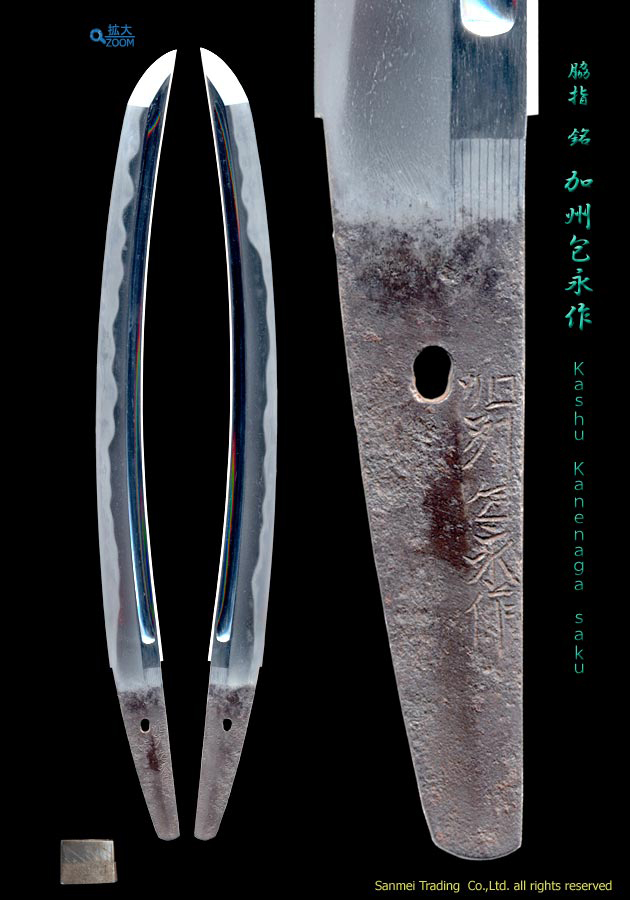
Figure 1- Photograph of both sides of the Blade. This shape is like the
one show in figure 7 page 12 of Martin (2010))
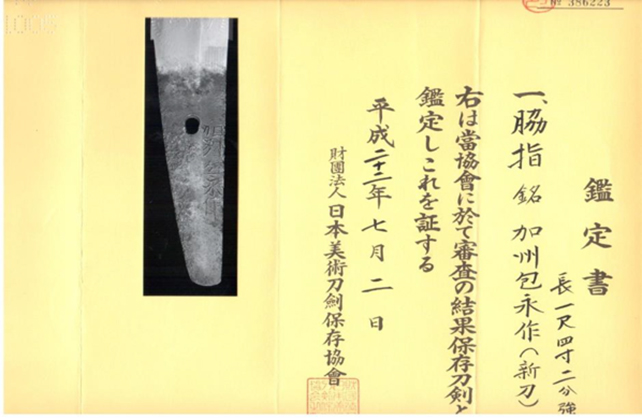
Figure 2- NBTHK Hozon Certificate dated Heisei 22 (2010).
Sword description: The katana
Another sword
by a smith with the same name was sold by Katana Boutique. Figure 3 is a
photograph of the shape and of the nakago of
this sword. The NBTHK attributed it to the same smith’s name and time period (Shinto). The signature includes the kanji
住(Ju) and the carving of the signature is slightly different than our subject
sword. However, the certificate says Kashu Kanenaga in the Shinto
period and so one can assume these are made by the same smith. A copy of the
certificate showing the signature is reproduced below In
Figure 4.
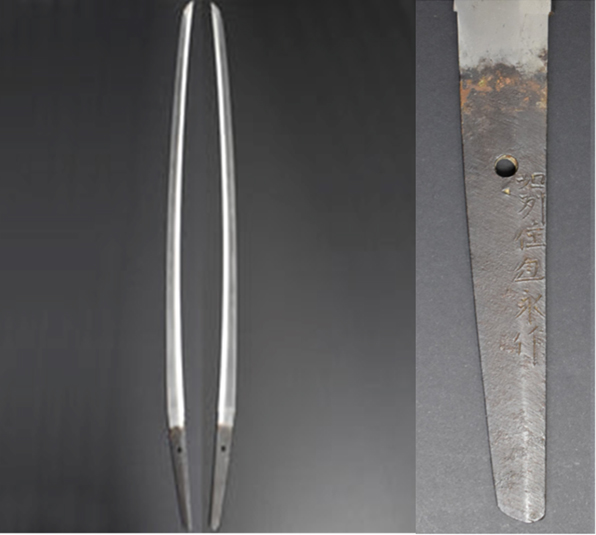
Figure 3- The signature of the same smith on another sword. Note that
there is a 住(JU) and a 作 (SAKU) in this signature.
In Figure 3
above one can see the shape of this katana. The shape shows a tori-zori with
a very shallow saki- zori and narrowing towards the point.
It is typical of the late Muromachi to the beginning Keicho. See for example Paul Martin booklet (Martin
(2010)) where the shape is like the one in Figure 6 on page 6, but
longer. Also, please compare the sword shown in figure 175, page 148 of (Nakahara
(2010)).
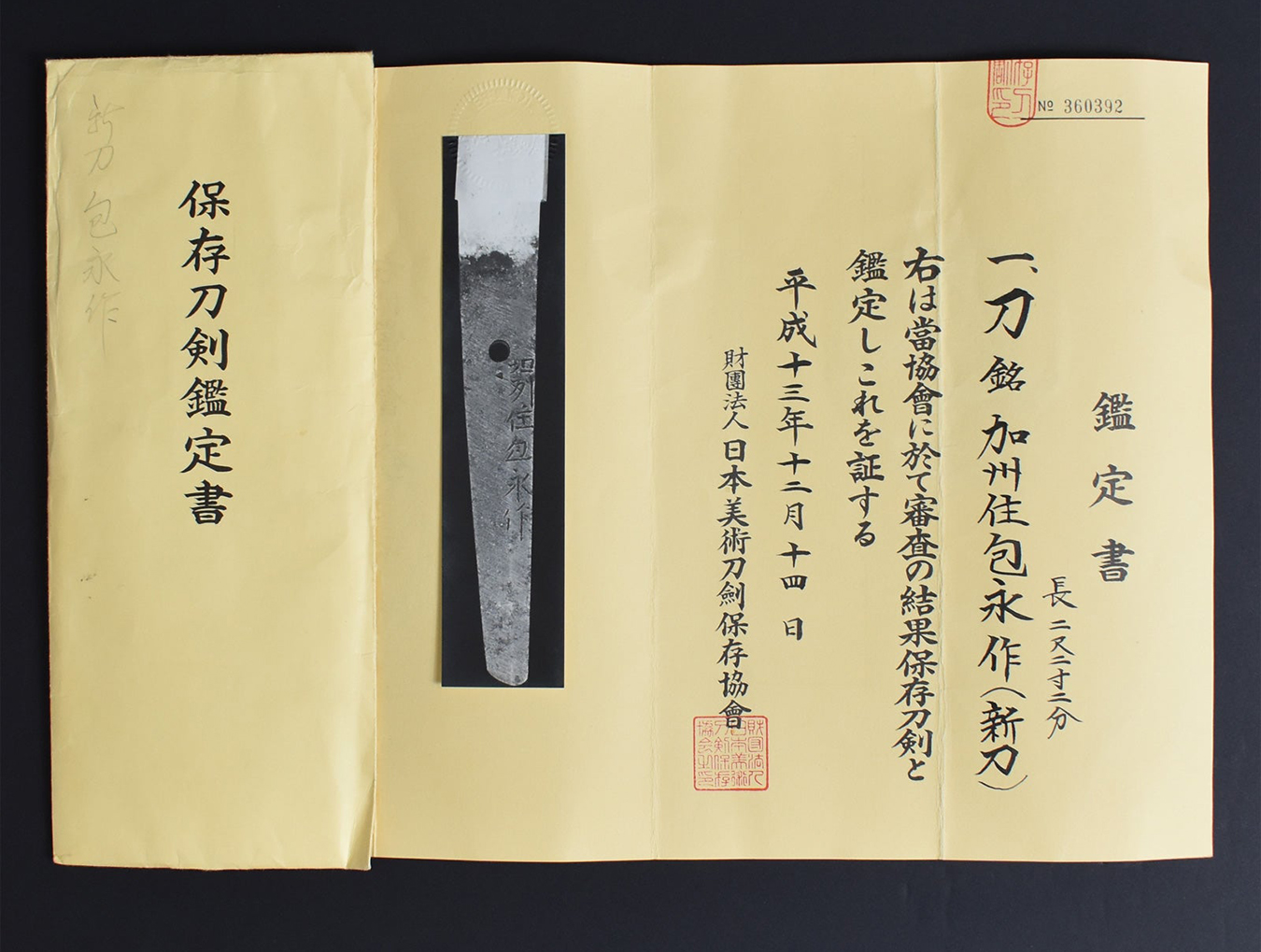
Figure 4- The certificate (issued in 2000) of the above sword indicating
that is the work of the smith that worked in the Shinto period.
The
measurements of the katana are as follows: Nagasa =67.3
cm, Sori=1.5 cm, Moto Haba=3.7 cm,
Saki Haba =2.47 cm
Blade description: The Yari
Figure 5 shows a photograph of a Yari.
Note, for future comments, that this signature does not contain the two kanji) 藤原 (FUJI WARA nor the
kanji 作 (SAKU). However, is does use the same kanji for 包(KANE) and 永 (NAGA) Could
this be the smith be our smith?

Figure 5-The signature is like our subject sword. It used the same 包(KANE) and 永(NAGA) but does not include 藤原 (FUJI WARA) or 作(SAKU).
Attempts to Identify this smith in more detail as if we lacked certificates.
What follows is an intellectual effort to understand
the NBTHK attribution.
Some time ago it was very common to find swords for
sale with no certificate and in poor polish. Collectors tried to identify the
smith, and this was done in at least three stages. In this case this is indeed
futile because as shown above the smith who made the wakizashi and the katana were identified by the NBTHK. If there
were no certificates the steps collectors had to follow a long time ago will be
considered.
Step 1-Searching for the signature.
The first step is to search
the smith in books containing list of signatures. In this case this smith is
rarely mentioned in the literature. Some books, mention just one smith with
this name and with the general statement that he worked in the Azuchi- Momoyama period. For example, Tokuno Kazuo (Tokuno
(2004), page 60) mentions only one Kashu Kanenaga in Kaga,
working in Eiroku, and stressing that
his work has sunagashi and that it is wazamono.
But
other books mention two Kashu
Kanenaga one working around Eiroku the other working in Keicho: Marcus Sesko,
(Sesko (2012)), conjectures that the smith
working in Keicho is a second generation of
the one working in Eiroku.
In
three books listed below, the signature of the one working during the Keicho era includes the characters for Fujiwara
but not a Saku, namely the
signature should read, Ka Shu Ju Fujiwara Kanenaga.
Hawley (Hawley (1998) page 124)), however, has the
Fujiwara in this signature but it is optional.
Another point to note is that in the books by Hawley (Hawley (1998) page
124)) in the Meikan
(Honma (POD), and in the book by Shimizu Osamu (Shimizu (1998)
-page 111, for the Shinto smith
and page 110 for the Koto Smith), the Kashu Kanenaga working
in Eiroku includes a 作 (saku) in the signature which is not included
in the signature of the sword smith working in Keicho.
Furthermore, in the books
the signatures of both smiths include a 住(Ju) that is absent in our wakizashi. The books by Hawley (Hawley
(1998), Shimizu (1998) and Honma
(POD) will be referred as the books from now on.
To finish this analysis, the value of the two smiths
in the books mentioned above should be considered and is as follows. In the
book by Hawley the value of the smith working in Eiroku (hence Koto) is the same as the value of the smith
working in Keicho
(hence Shinto) and it is 15 points.
In the book by Shimizu, however, the Koto smith is rated as Ryo (良) that is good, and the Shinto one is rated as Hey (並), that is common. In the book of Tokuno (Tokuno (2004)) the value of the Koto smith (the only cited) is 3.000.000 Yen.
The above leads to the following (false) conclusions.
1) One would be in doubt about the wakizashi.
It does not contain the 住(ju) that is mentioned with respect to both smiths in the books.
2) One would conclude that the katana is by the Eiroku smith
because it contains a 作 (saku) at the end of the signature,
that is the signature is 加州住包永作. On the other hand, one would conclude that the smith
who made the yari is the one who worked around
Keicho
because his signature is
加州住包永 exactly as the books say it should be. But seasoned collectors
would move to step 2 designed to see if the signatures match with the
signatures in the oshigata
books.
Step 2) Examining the signatures.
Without the NBTHK certificates one would compare the
signatures of the pieces. Comparing the
signatures of the wakizashi and the katana the probability that one of them
or both could be fakes should be considered.
The signatures appear to be carved differently but
this might be because the smith used a different tool to carve since the wakizashi is small compared with the
katana. To say that they are from different smiths would imply that one of them
(or both) is (are) unlisted or a fake(s). There are unlisted smiths, that is,
by definition, not listed in the Meikan and that they are probably quite a few but not too
many. The Meikan is a compilation of 23,000
smiths and Hawley claims to have 30,000 smiths. This gives roughly a prevalence
of 800 -1,400 smiths working each year since the year 800 CA. So, despite the
differences, one may assume that they are the same smith. In addition, since neither
is a dated example, one may rely on calligraphic differences and from this
point of view they are the same smith. The signature in the yari, calligraphically, may also be considered by the same smith.
Step 3) Comparing the signatures with known oshigata
This step consists in looking in books that have oshigata (or,
more recently, photographs) of true signatures. This step proved to be very
unsatisfactory. Only two examples were found. The first one is shown in Figure
7a and was taken from the book by Iida
Kazuo (Iida (2011)). The second one is from the old book Kôzan Oshigata
reproduced in Figure 7b This last one
is not an oshigata but a hand copied signature. So, it
should not be used for details.
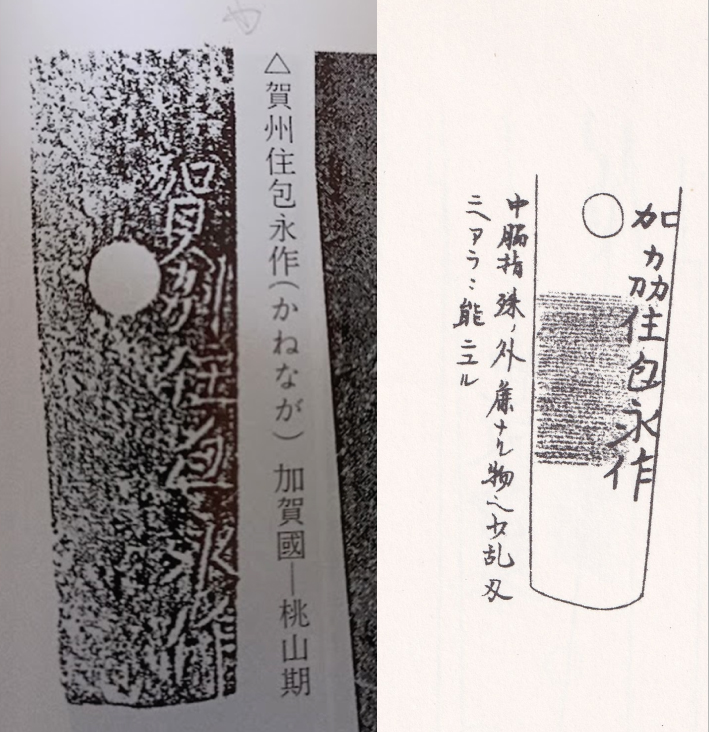
Figure 7a Figure 7b
Figure 7a) Photograph of an oshigata that appears to be from
our smith because it is from the Momoyama period Figure 7b) Photograph of the signature of
one of the two smiths in the book Kozan Oshigata
Next compare the two oshigata. The two examples appear
to be the same signature, but with minor differences.
Consider the following points.
a) The first kanji Ka in the figure 7a example is the second
kanji Ga of Kaga (加
賀) namely 賀. In the second example it is the first kanji Ka of Kaga namely 加.
b) The kanji 州(shu)
are similar: The
first example uses two chikara characters on the left side [力] top to bottom. The second example
is different because it uses three 力.
c)
On the other hand, both use the kanji 作 (saku) at the end of the signature.
d) The two examples have a 住(ju).
e) Both examples show
the yasurime
as kiri.
Comparing the signatures of the swords with the oshigata in Figure 7a and 7b follows.
a) The two swords and the yari and the oshigata 7b use the same first kanji
for kaga (加), whereas the oshigata 7a uses
the second kanji (賀) for kaga. It should be noted that Shinto Kaga smiths
like Kanewaka
uses the kanji (賀) for kaga.
b)
In both oshigata
the Shû (州)use two chikara characters on the left side [力] top to bottom. In the swords this is
different.
c)
Both the 永(naga) and 作 (saku) kanji are also somewhat different.
d)
The two swords have deep kate sagari yasurime (almost sugikai) while the two oshigata have kattesagari which is more prevalent on kotô works.
d)
In the yari the first kanji (加),) is the first kanj for kaga and the signature does not have the 作(saku) at the
end. It
should be noted that many Shinto
smiths (like Kaga Kanewaka)
of the period did not include 作 (saku) at the end of their signatures.
Concentrating
on the main difference that is in the first kanji,
it does not match the first kanji of
the swords or the yari. Furthermore, the inscription on the side
of the oshigata
in Fig 7a says that the smith is from the Momoyama (which begins in Tensho and goes
to Keicho so it is a very early Shinto. So, we are tempted to say that
both oshigata
are of the Shinto smith and that our
smith is the Koto one. But there is a
discrepancy. The yari has the simple (Ka) Kanji. However, the signature does not
have the saku
at the end. Therefore, the yari might have
been later in the Shinto period.
To
summarize: Naively one might conclude
that the swords are Koto (which is
false), the yari is Shinto and the oshigata are Shinto (which is true). Wrongly this summary does not take into account the fact that the certificates say that
the swords are Shinto. What is needed
is a conclusion that explains every item considered.
One
might also conclude in absence of more information, that the three pieces are Shinto (true) and the oshigata are from the Koto (false) smith despite the annotation (Momoyama) on the side of the oshigata in figure 7a. The two oshigata have in common the kanji for shu
that is more prevalent in the Koto period.
To
summarize: One might conclude that the oshigata
are from the Koto smith and three
pieces are from the Shinto smith (true)
despite of the of the kanji 作 (saku) in the swords
that is absent on the yari.
The existence of the kanji 作 (saku) in the
swords make this conclusion inconsistent with the books. This
explanation also does not agree we all the facts we have.
Since
the conclusions above are contradictory, we are forced to do what we should do
in the first place, that is, to examine the swords and abandon for now the hope
of identifying the smiths by the signatures. This is extra information that we hope
may explain all the information we have.
Step 4)
Examining in more detail the shapes of the swords and of the yari.
There are two measurable properties that
need to be considered. The width of Japanese
swords diminishes as we go from the base to the point. This is a very important
point in kantei.
We can calculate a number to characterize this change. It is given by the
difference between the width of moto haba and the width of the saki haba divided by the width of the moto haba.
This number is called funbari in some auction catalogues Christies's(1992). We shall use this name although, technically, funbari is a different thing (Robson (2005)).
The second number will be used to characterize the curvature of the
sword. It is given by the nagasa divided by
the sori. One can call this number
curvature.
For the wakizashi the funbari is 26% and the curvature is 4
%
For the katana the funbari is 33% and the curvature is 3.7%
Short stocky wakizashi like the Kanenaga
are typical of late Muromachi
and early Keichô shaped blades. They are rare, not
elegant and are usually called Bukotsu. Shinogi-zukuri wakizashi are not as plentiful during Eiroku as hira-zukuri ko-wakizashi (one
shaku, one or two sun). Eiroku shinogi-zukuri
wakizashi tend to be narrower and
longer (one shaku, five sun or so).
However, it can be considered an exotic late Muromachi or early Keicho. Let's compare the funbari and curvature of the wakizashi
with the same measures for a typical late Muromachi or early Keicho shape. The
wakizashi has a curvature of 4% and a
funbari of 26%. The first example is a sword by
Bushu Terushige
dated Bunroku (1595). It has a Nagasa 1 shaku, 9 sun
5 bu and 5 rin.
This can be better described as 1.955 Shaku.
Its Sori is 6 bu and 5 rin or 0.065 shaku. So, its curvature is C=3.3%. The
funbari can
be estimated and is 16.7%. The second example is a
sword by Bishu Mihara Masachika dated Tensho (1573–1592). It has a nagasa
of 1.91 shaku and a sori of 0.04 shaku. So. its curvature is C=2,0% and its funbari can be estimated to be 35.59%. Yet another example is a sword by Uda Kunimune,
dated Tensho
with a nagasa
of 48.2 cm and a sori of 1.22 cm. Hence its curvature is 2.5% and an estimated funbari of 30.76%.
Finally, a fourth example is a sword by Yoshisuke saku dated Bunroku (文禄) (1592). Its nagasa is 28.8 cm and its sori
is 0.82cm. So, its curvature is C=2.84%. Its funbari can be estimated and is 21.1%
The above numbers can be
considered exaggerated with respect to the numbers of a wakizashi by Tamba Kami Yoshi Michi working in the Keicho era from
1595 to 1600. This sword has a funbari of 12% and a
curvature of 2.7%. It also does not compare well with a sword by Kunihiro (Keicho) with a Nagasa of 49.1 cm and a sori
of 1.3 cm that has a curvature C=2.5% and a funbari of 19%.
Thus, our sword compares
better with very late Muromachi
or early Keicho
although is not entirely typical. As mentioned above swords of this type are
called bukotsu and are considered inelegant. This
sword is very unusual and so it is to be expected that it does not compare well
with more typical examples. It is very difficult to find these bukotsu swords
in the literature. Moreover, it is very difficult to find shinogi zukuri wakizashi in the Eiroku era. So, it is not possible to carry out a
statistical analysis of the shape to decide if our sword is Eiroku or Shinto. What can be said
is that our sword is not a typical Keicho wakizashi, that has also usually a bigger kissaki. One
can conclude that the wakizashi is very late Koto and of a special type. A fighting sword,
not an art sword.
The katana is also not a typical Keicho sword, that looks a like suriage Nambokucho swords.
Our katana has a shallow tori zori, which
can be considered typical of Keicho era, but its haba narrows when we go from the base to the kissaki which is small and hence not a typical Keicho sword. In fact,
the funbari
is 33% and its curvature is 3.7%. let's
compare this with a sword by Yasutsugu (Shodai),
signed Higo
Daijo Fujiwara Shimosaka
and the NBTHK 33 Juyo Token. It is a very early Keicho sword with nagasa is 74.55 cm
and sori is 1.82 cm moto haba 3.0cm and
saki haba
2.1cm. So, the funbari is 30% and the curvature is 2.4%. Its kissaki
is not big. Another early Keicho sword by Kunihiro has a nagasa
of 71.6 cm and a sori of 1.2 cm. The moto haba
is 3.2 cm and the saki haba
is 2.6 cm. So, the funbari of this sword is
18.7% and its curvature is 2.23%. The kissaki
of this sword is big, typical Keicho.
So, from the shape one can argue that both the katana and the wakizashi were
made between the late Tensho
era and early Keicho
era but not too late. It is easy to find katana from the Eiroku
period and they do not compare well with our katana.
The yari
has a Shinto shape and was prevalent
in the early Edo era. The yari is the newest piece among the three
pieces and can be little doubt that is Shinto.
Consider all the information
Assume that the three pieces were made by the same
person but at different times. One can do this because
stylistically the signature on the katana
and on the wakizashi are the
same. The signature in the yari is also stylistic the same as the signature of the two
swords.
1)-The wakizashi
was probably made lately during the Tensho era that is in the Momoyama period at the end of the Koto
era.
2) The katana was probably made in the early Keicho era and
the yari a bit later. This shape of yari was very prevalent in the early Shinto period.
Conclusion:
This agrees we the shapes of the pieces and the wakizashi although very unusual is called bukotsu and made for combat.
3) The Kozan oshigata was copied from a piece made in
the Keicho
era but later than our katana. The side inscription of the Kôzan's oshigata notes
that it is a medium sized wakizashi with
a midare-ba hamon (it
looks to be hira-zukuri). This explains the kiri yasurime and
the use of the simplified first kanji for Kaga.
4) The oshigata in
the book by Iida Kazuo was taken from a piece later than the study pieces and made
near the end of the Keicho era or immediately after. This explains
the use of the complete Ka first kanji which
we found on swords by the early Shinto Kaga smith Kanewaka, but still in the Momoyama period. (Tensho to Keicho). Kanewaka also used kiri or kate sagari yasurime.
Conclusion: The
hypothesis 3) and 4) explains why the oshigata are different.
5) The information in the books can be understood as
follows. The signature in the katana
and on the wakizashi were made from Tensho to the beginning of Keicho, that is at the beginning of his career. This explains the use of
the saku in the two pieces and its absence in
the yari.
The absence of
the kanji 住(ju) in the wakizashi can be overlooked
considering how different this sword is. It is unique in our experience and perhaps
an experimental design. Conclusion: The above
explains the information in the books about the signature of the two smiths.
The books list the most prevalent signatures. We have pieces outside the range
that can be considered more prevalent.
6) Finally, one
can understand the NBTHK attribution. The smith worked at the very end of the Koto period and begin of the Shinto period, but surely not during the
Eiroku era and so he is not the Koto smith. Accordingly, the NBTHK had
to say that the pieces are Shinto to make it clear that this smith was
the less valuable one, that is the one working in the Shinto period.
Conclusion:
This explains the NBTHK attribution. As is well known the certificates do not
explain the reasons for the attributions.
This is perhaps inevitable and desirable for several reasons, but it
sure looks like “it is so because we said so”.
Overall Conclusion
The NBTHK is correct. Did they have more information
than the author? An oshigata
of the smith working in Eiroku
with a good description of the work or even better a dated specimen would
clarify the whole issue.
Without that definitive information one can only
conclude that our smith is just a common one who experimented by making an
interesting wakizashi and that was good
for close combat.
Acknowledgments: Thanks to Gordon Robson for reading an early version
of this paper and for sending me the two oshigata. Thanks to Brent Tanner
for some revisions of an early version of this paper and for suggesting the
title. Thanks to Barry Hennick for editing the paper extensively. All mistakes
in this paper are solely my responsibility.
References
1) DeVries (2006)- Kelly DeVries,
Infantry Warfare in the early fourteen century, Boydell & Brewer
LTD, Rochester, NY
2) Nakahara (2010)- Nobuo Nakahara, Facts and Fundamentals of Japanese Swords. A Collector’s
Guide, Kodansha International, Tokyo.
3) Tokuno (2004)- Tokuno
Kazuo, To Ko Tai Kan.
4) Sesku (2002)- Marcus Sesko, Index of Japanese Swordsmiths A-M, page 195
5)Martin (2010)- Paul Martin, The Japanese sword. Guide to Nyusatsu
Kantei.
6) Haley (1998)- W. H. Hawley, Hawley’s Japanese Swordsmith, Panchita
Seyssel-Hawley page 124.
7) Honma (POD)-Honma Kuzan
and Ishii Masakuni, Nihonto
Meikan, Yuzankaku,
Tokyo.
8)-Shimizu (1998)- Shimizu Ozamu, Tosho Zenshu,Bijutsu-Club,
Tokyo
9)- Iida (2011) - Iida Kazuo. Tômei Sôran,
Tokyo
10)- Robson (2005)- Gordon Robson, Glossary of Japanese Sword terms, Japanese Sword Society of the
USA, Inc.
11)- Christies's (1992)- The Compton Collection Sale, New York